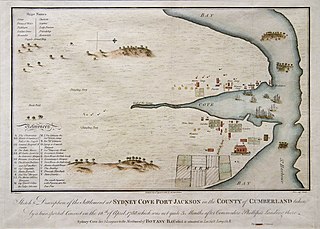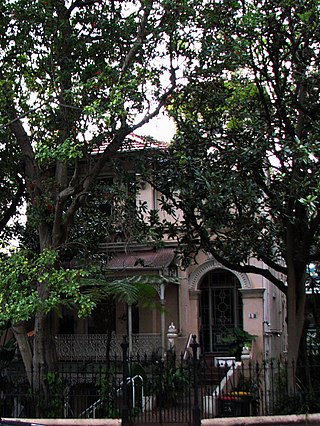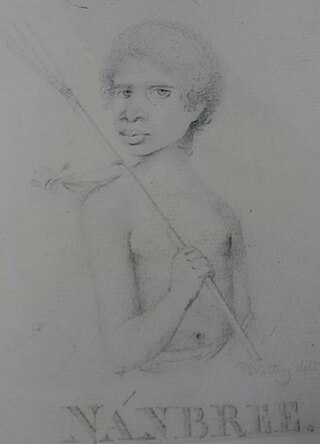
Sydney Cove is a bay on the southern shore of Sydney Harbour, one of several harbours in Port Jackson, on the coast of Sydney, New South Wales. Sydney Cove is a focal point for community celebrations, due to its central Sydney location between the Sydney Opera House and the Sydney Harbour Bridge.

The Dharug or Darug people, are an Aboriginal Australian people, who share strong ties of kinship and, in pre-colonial times, lived as skilled hunters in family groups or clans, scattered throughout much of what is modern-day Sydney.

The Wangal people are a clan of the Dharug Aboriginal people whose heirs are custodians of the lands and waters of what is now the Inner West of Sydney, New South Wales, centred around the Municipality of Strathfield, Municipality of Burwood, City of Canada Bay and former Ashfield Council and extending west into the City of Parramatta.

Lewisham is a suburb in the Inner West of Sydney, in the state of New South Wales, Australia. Lewisham is located 7 kilometres south-west of the Sydney central business district, in the local government area of Inner West Council.

The Eora are an Aboriginal Australian people of New South Wales. Eora is the name given by the earliest European settlers to a group of Aboriginal people belonging to the clans along the coastal area of what is now known as the Sydney basin, in New South Wales, Australia. The Eora share a language with the Darug people, whose traditional lands lie further inland, to the west of the Eora.

The Municipality of Leichhardt was a local government area in the inner-west region of Sydney, New South Wales, Australia. It is about 10 kilometres (6.2 mi) west of the Sydney central business district. On 12 May 2016, Leichhardt merged with Marrickville Council and the Municipality of Ashfield to form the Inner West Council.

The Dharug language, also spelt Darug, Dharuk, and other variants, and also known as the Sydney language, Gadigal language, is an Australian Aboriginal language of the Yuin–Kuric group that was traditionally spoken in the region of Sydney, New South Wales, until it became extinct due to effects of colonisation. It is the traditional language of the Dharug people. The Dharug population has greatly diminished since the onset of colonisation. Eora language has sometimes been used to distinguish a coastal dialect from hinterland dialects, but there is no evidence that Aboriginal peoples ever used this term, which simply means "people". Some effort has been put into reviving a reconstructed form of the language.

The Bidjigal people are an Aboriginal Australian people whose traditional lands are modern-day western, north-western, south-eastern, and southern Sydney, in New South Wales, Australia. The land includes the Bidjigal Reserve, Salt Pan Creek and the Georges River. They are part of the Dharug language group, and there is debate as to whether the clan is part of the Dharug or Eora people.
Koori Radio, is a community radio station based in Redfern broadcasting to Sydney on a citywide licence. Since the early 1990s it has been part of the Gadigal Information Service (GIS), and is the only radio station in Sydney providing full-time broadcasting to the Aboriginal and Torres Strait Islander community.

Yininmadyemi - Thou didst let fall is a sculptural artwork by Indigenous Australian artist Tony Albert located in Hyde Park, Sydney. Unveiled on 31 March 2015, the artwork acknowledges the service of Aboriginal and Torres Strait Islander men and women in the Australian Defence Force.

Oakleigh is a heritage-listed residence and former boarding house at 18 Ward Avenue in the inner city Sydney suburb of Potts Point in the City of Sydney local government area of New South Wales, Australia. It was built c. 1880 on the former estate of the now-demolished Goderich Lodge. It was added to the New South Wales State Heritage Register on 2 April 1999.

55 Victoria Street is a heritage-listed residence and former boarding house and Catholic Women's Association hostel located at 55 Victoria Street in the inner city Sydney suburb of Potts Point in the City of Sydney local government area of New South Wales, Australia. It was built in 1875. It was added to the New South Wales State Heritage Register on 2 April 1999.

Jenner House is a heritage-listed residence located at 2 Macleay Street in the inner city Sydney suburb of Potts Point in the City of Sydney local government area of New South Wales, Australia. It was designed by Edmund Blacket and built in 1871, with an 1877 third-floor addition designed by Thomas Rowe. It has also been known as Fleet Club, Stramshall, Jenner Private Hospital, Kurragheen and Lugano. It was added to the New South Wales State Heritage Register on 2 April 1999.

181–187 Hay Street, also known as the Corporation Building or Municipal Building, is a heritage-listed former council chambers located at 181–187 Hay Street, in the Haymarket district of Sydney, Australia. It was built from 1893. The property is owned by City of Sydney and was added to the New South Wales State Heritage Register on 2 April 1999.

The Bulletin Place Warehouses are a series of three heritage-listed former warehouses and now souvenir sales office, commercial offices, health club, storage area, and restaurant located between 6–18 Bulletin Place, in the Sydney central business district in the City of Sydney local government area of New South Wales, Australia. The warehouses were built from 1880 and have variously been known as the San Francisco Restaurant. The property is privately owned. It was added to the New South Wales State Heritage Register on 2 April 1999.
New South Wales Aboriginal Education Consultative Group Office, abbreviated as NSW Aboriginal Education Consultative Group Office, is a heritage-listed former Aboriginal land, farm and house and now education centre and teacher-training facility at 37 Cavendish Street, Stanmore, Inner West Council, New South Wales, Australia. It was built from 1887 to 1888. It is also known as NSW Aboriginal Education Consultative Group Office and Records and NSW AECG Office. It was added to the New South Wales State Heritage Register on 19 January 2018.

"Gadigal Land" is a song by Australian rock band Midnight Oil featuring Dan Sultan, Joel Davison, Kaleena Briggs and Bunna Lawrie. The song was released on 7 August 2020. It is the band's first single in 17 years, and is part of The Makarrata Project, a themed mini-album of collaborations with Indigenous artists.

Gringerry Kibba Colebe also spelt Colebee, Coleby or Colbee, was an eighteenth-century Gadigal man, an Aboriginal Australian people from present-day Sydney, New South Wales.

Nanbaree, also named Nanbarry and Andrew Snape Hamond Douglass White, was an Aboriginal Australian of the Gadigal clan who undertook a prominent role in establishing communication between the Aboriginal people and the colonists during the early stages of British occupation of the Sydney area. While still a child, he was the first Aboriginal Australian to acquire a functional level of English and became an important interpreter as he had very close kinship ties with prominent figures such as Bennelong and Colebe. During adulthood, he became a notable sailor, voyaging with Matthew Flinders.